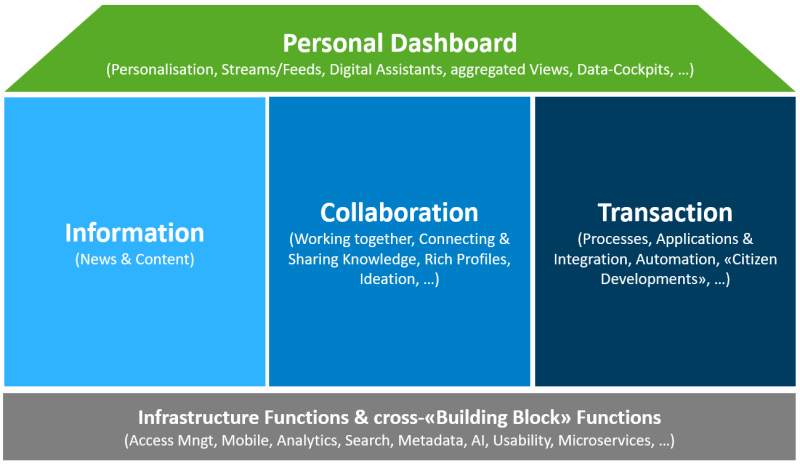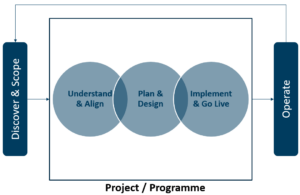In Dialogue: Do SME-Intranets really have to be unsophisticated and boring?
Published October 2, 2023 by Stephan Schillerwein
This post belongs to the series “In Dialogue” by Schillerwein Net Consulting. This series pursues the goal of helping you to master the complexity inherent in Digital Work by bringing together complementary expert perspectives to shed light on all the facets required to create a great Digital Employee Experience.
This dialogue took place with Marko Cincar, the founder of Invento, an Intranet Consulting company based in Croatia. Marko has far-reaching experience in designing and implementing Intranets for Small and Medium Enterprise (SME) all around the world.
At conferences and award ceremonies, it is typically the Intranets and Digital Workplaces of large companies that take center stage. Many a person responsible for an SME organization’s Intranet stop looking at such examples of Intranet best practices when they hear about the sizes of the Intranet teams behind such successes. Most SME’s don’t even have a dedicated Manager for their Intranet, let alone a whole team! With such fundamental restrictions, the thought is obvious, that a SME-Intranet can only be a very simple instrument, capable of catering to only the most basic needs of the organization and its employees. But is that really the case?
Stephan:
From my experience in working with over a dozen of SME companies on their Intranets – and I would include companies from ca. 100 to ca. 1’000 employees in this category – it seems to me, that there is quite a number of “SME-Intranet Myths” out there, that lead to a self-restricting view as to what a SME can achieve with their Intranet.
One of those myths is that the more expensive Intranet platforms out there have a far bigger spectrum of functionalities and therefore one is stuck with much less possibilities if no big budget for such a system exists. And while it is of course true, that the market offers cheaper and more costly options, more expensive doesn’t automatically equal better and less expensive doesn’t necessarily mean that a system is not powerful. From my experience, lack of budget in this area can be made up for by using extra creativity in finding an affordable alternative and making best use of it.
But let’s not dive too deep into a discussion around systems just yet! What “SME-Intranet Myths” do you encounter on a regular basis?
Myths about SME-Intranets
Marko:
The first myth that comes to mind is that setting up an intranet requires a large team of people and IT experts. While this might be the case if you are building a new intranet from scratch for a large organization, a typical intranet implementation for SMEs does not require such resources. From my experience, most successful intranet implementation projects for SMEs were done by a small team of 4-5 people and 1 dedicated IT resource.
Another one is that intranets take a long time to implement. This might be true if you are building the intranet on your own and you don’t have enough resources for the project. However, with an out-of-the-box intranet solution, the implementation process normally takes 10-16 weeks depending on the intranet platform you choose.
Stephan:
These are great examples! But putting these myths aside and coming to a key question that many readers will have by now: Have you ever seen SME-Intranets that are as good as “big Intranet” of a large company?
Marko:
Absolutely, I have encountered this on more than one occasion. As an example, we can take a look at one SME I recently worked with. This is an organization of 200 employees, and they decided to use their intranet as a central hub for all company information. Each department has its dedicated page on the intranet and they publish news, guidelines, and other information on a regular basis. They also integrated other apps they use with the intranet so that their employees can easily access them all from one place. Other features were also configured, such as monthly newsletter, email/SMS notifications, as well as video vlogs from their CEO, all centralized and coming from their intranet platform.
Key Success Factors
Stephan:
What would you say where key success factors in this project?
Marko:
What was crucial for the success of this intranet was planning. Their team had clear goals and objectives which were identified at the beginning of the project. They also did a lot of research and picked an out-of-the-box intranet solution that seamlessly integrated with their existing systems/apps. Another important piece of the puzzle was the communications plan for the implementation. As we were building an intranet, announcements were sent to employees in order to let them know what was coming and to educate them on the platform even before it was launched. This ensured high adoption after the launch.
An important takeaway in this case is planning. Before starting the project, it is crucial to do research and determine your objectives for the intranet. Also, you will need a dedicated team for the project. For SMEs, it is recommended to have 1-2 people who will manage the intranet on a global level (admins) and a team of 3-5 people in charge of content management. Ideally, those people would represent different departments in the company. You will also need a dedicated IT resource who will be in charge of integrating 3rd party apps and SSO (single sign-on).
Stephan:
I agree, this reflects my own experience as well. Maybe to add to what you just said, in the SME projects that I was privileged to work on, I often encountered a strong spirit of pragmatism. This made things possible that much bigger companies often fail to achieve due to more complex processes, red tape and even lack of boldness. A “just do it” attitude often can, in my experience, offset at least some of the limitations that a lack of budget and people resources brings with it.
One of the most ambitious projects I have worked on in the last couple of years was actually for a company with just around 100 employees. One of the success factors in this specific project was a focus on business processes (as opposed to primarily concentrating on News & Content). This gave the Intranet project a high level of attention across the whole organization and also helped with getting more resources than were planned at the beginning of the project.

An Intranet doesn’t have to be “News & Content” only – in fact, your employees’ needs go much further
Any other ideas how a small budget might be made bigger?
Marko:
I agree with you when it comes to pragmatism in SME projects. I would say that it is much easier for SMEs to follow up on the execution of their intranet objectives than it is for large enterprises.
This also means that the implementation will take less time than it would for a larger organization. If you have your team in place, and your objectives clearly defined, the project timeline can be significantly reduced. In my case, I had one intranet implementation project that took only 4 weeks to deploy. It was initially planned for a span of 8 weeks, but the team was well prepared and we managed to finish much sooner. Of course, the job is not done after the launch, but it goes to show how quickly the intranet can be deployed if the team is prepared for the project.
Another thing that can influence the budget if a company is going for an out-of-the-box intranet solution is the add-ons that intranet vendors offer, such as customization options, AI assistant, newsletter feature, etc. Perhaps, these are not a necessity for the initial launch. After determining your objectives, you can focus on the MVP product and just go with the features that are absolutely essential for the initial launch. Later, as your needs grow, you can upgrade your intranet with additional features.
Software for SME-Intranets
Stephan:
Ok, so let’s come back to the more technical discussion around systems and features.
When talking to SMEs, I’m often amazed to see that many of them are not really aware of the offerings available on the market that specifically aim at smaller organizations with more restricted budgets. Ironically, many seem to not even be aware of the fact that there are powerful but free systems out there, that can be used to build their Intranet, like e.g. the community editions of open source Content Management or Portal systems.
What other market segments do you see that are especially suited as a SME-Intranet platform?
Marko:
There are many free content management systems SMEs can use as their intranet platform. However, these will require some expertise to set up and it could take longer to implement them. Depending on a company’s technical resources and budget, free solutions could be the best choice.
On the other hand, out-of-the-box intranet solutions will take significantly less resources and time to implement. Of course, this means that you will need a budget for the intranet as these are paid solutions. Another important aspect to consider is the support you will get from the vendor. It is really important to know that you can rely on them during the implementation and post-launch in case you encounter any issues or questions.
The ones I had really good experiences with when it comes to SMEs are Simpplr and Haiilo. These platforms offer a lot of features and are often the best choice for SMEs. Both platforms allow you to design your own layout of the intranet and customize it so it reflects your brand. They also have a social component, meaning that employees can like, share, and contribute content if needed.
In conclusion, selecting the ideal intranet platform will depend on the company’s objectives and budget, as well as its technical expertise.
For more information:
Work on your Concept first
Stephan:
This brings us to another point, actually, to the step before selecting a system. Before a company is in a position to choose the right system for their Intranet, they need to be clear about their requirements. This is where I find many SME’s struggling, as the more strategic-conceptual steps of an Intranet project are less common in smaller organizations. Doing an analysis, working out an Intranet strategy or even describing and prioritizing use cases isn’t something that most SME’s are super familiar with.
In fact, many of the SME’s that I worked with, considered the system evaluation to be the first step in the project and were amazed to learn that there is quite some way to go before we would come to that work package.
That doesn’t mean that the concept phase has to be long and effortful – in fact, this can be done in a very lean way in most SME’s as there are typically no fixed frameworks in place for this and the stakeholders don’t have too high expectations in this regard.
What would you say: which steps in an Intranet project do SME’s focus on too much and which ones don’t get enough attention?
Marko:
I think we can make a point that it should not be any harder for SMEs to determine their objectives and requirements for the intranet than it is for large enterprises. This is because they don’t have complex processes and procedures that they have to follow like large organizations do. However, it seems that SMEs are often not familiar with this critical step before selecting their intranet platform.
Intranet platforms should always be chosen based on the company’s objectives and requirements, so this is the first step in the process.
A mistake I often see in intranet projects is that SMEs are focusing too much on the branding and fancy features, rather than the content itself. Don’t get me wrong, applying your brand colors and logo on the internet is important, but it is a small piece of the puzzle and it normally doesn’t take long to set up.
On the other hand, a lot of SMEs are struggling with content governance. From my experience, this is the leading cause of poor adoption rates from employees. I always encourage my clients to determine roles in the intranet as soon as possible. When it comes to content, it is crucial to know who is responsible for content creation. Ideally, you should have at least one person from each department who will decide which content needs to be published and who needs to publish it. Otherwise, your intranet could end up with a lack of relevant content, or it can become a dumping ground for outdated content that nobody reads. Regular monitoring of existing content and planning new content is also very important. I would recommend that the intranet team meets at least once a month to decide which content will be published in the future and which content needs to be removed. Having a content editorial calendar will help a lot in this case.
In your experience, what are the main obstacles for SMEs, when it comes to determining their requirements and doing the initial analysis before selecting an intranet solution?
Find out what you really need
Stephan:
Many companies actually seem to have some kind of “allergy” against doing an analysis. Arguments like “when we ask people, they will expect us to implement all that they tell us” or “this will take us longer than the implementation itself” or even “this will only lead to analysis paralysis” are often cited. All these points can easily be dispelled though and – if you do the analysis right – will not be a problem in the project.
One thing many people don’t realize is that many things that an analysis could discover are actually already known. So, we can speed up the process by e.g. using benchmarking data from other organizations.
Skipping the analysis completely often leads to an unclear starting position when it comes to working out use cases and requirements. Many projects then resort to “this is what I want”-discussions, which typically lead to poor outcomes that are not aligned with what people really need.
Coming to the end of this “In Dialogue”, I would like to wrap up by each of us giving our top 3 tips for an SME that is thinking about creating their first Intranet or relaunching and extending an existing one.
2 x 3 Top Tips for SME-Intranets
Stephan:
From my perspective this would be:
- Be clear about the scope of your future Intranet and the concrete goals your organization wants to achieve with it
- Don’t try to imitate how larger companies approach an Intranet project (i.e., don’t do the same thing they are doing, just on a smaller scale), rather be very clear about the limitations you’re facing and find creative ways to counter them
- Think beyond the end of the project. Otherwise, chances are high that you will build something great (or at least a great foundation to further develop over time), only to realize that the real work starts only after your “Release 1.0”. While AI will definitely lighten or remove many of the classical Content Management burdens, there will still be much work to be done moving the Intranet ever forwards.
What would you “Top 3” tips be?
Marko:
Those are all great points. Here are my 3 recommendations:
- Define your objectives and plan for the implementation: Similar to what you advised, I would recommend that you determine your objectives and requirements for the new intranet before you start looking at intranet platforms. Once you know exactly what you need, it will be a lot easier to select the right platform.
- Prepare your team and assign roles: Before the project starts, determine who the intranet managers, content managers, and IT resource will be for this project. Make sure they have enough time to work on this project for the next 10-16 weeks.
- Focus on the content: Try to determine the main building blocks of your intranet and the content that belongs to them. Use a spreadsheet or create a map to display this information structure and share it with your team for feedback.
Stephan:
Fantastic! I think it is fair to say, that if you only follow these 2 x 3 tips, you’re Intranet project is much more likely to become a success, than if you don’t!
With that I want to thank you very much, Marko – and wish all our readers lots of success in their projects!
Picture credits:
- Snails on Mouse: “4 Easy Ways to Speed Up Your PC” by li kelly, https://www.flickr.com/photos/juegonaruto/16543916238/ (CC BY-SA 2.0 Deed)
- Digital Workplace Modell (“House”): by Stephan Schillerwein, Schillerwein Net Consulting Ltd
- Simple Project Modell: by Stephan Schillerwein, Schillerwein Net Consulting Ltd





